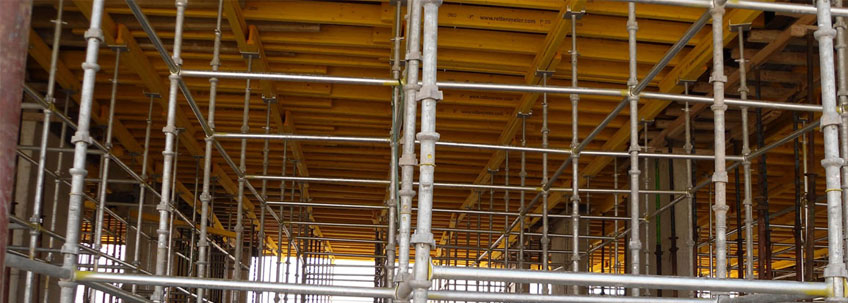
Beam brackets are integral to cuplock scaffolding systems, providing the essential support needed for internal downstand beams and enhancing overall stability. By transferring the load of beams onto the surrounding scaffold structure, these brackets eliminate the need for additional ground-based propping, ensuring safer and more efficient construction processes. This guide explores the significance, functionality, and best practices for beam brackets in cuplock systems.
What Are Beam Brackets in Cuplock Systems?
Beam brackets are specially designed components that connect directly to the vertical standards of a cuplock scaffolding system. These brackets serve as critical support elements, securely holding and distributing the weight of beams within the scaffold structure. By doing so, they play a pivotal role in maintaining the structural integrity of the scaffolding setup.
Key features of beam brackets include:
Key features of beam brackets include:
- Load Distribution: Efficiently transfers beam loads to the scaffold framework.
- Adjustability: Allows precise height and alignment adjustments for various beam sizes and spans.
- Durability: Made from high-strength materials to withstand heavy loads and environmental conditions.
- Ease of Integration: Compatible with a wide range of cuplock systems.
Key Benefits of Using Beam Brackets
1. Eliminates Ground-Based Propping
Beam brackets significantly reduce the need for separate ground-based propping, saving time, labor, and materials. This streamlines construction workflows and minimizes clutter on the ground level.
2. Enhanced Stability
Properly installed beam brackets contribute to the structural stability of scaffolding systems. By evenly distributing the load, they reduce the risk of structural failures.
3. Increased Versatility
Beam brackets can be adapted for various applications, including slab formwork and soffit supports, making them an indispensable part of modern scaffolding solutions.
4. Precision Adjustment
Many beam brackets come with jacking points or similar mechanisms that allow for precise height adjustments. This ensures beams are positioned accurately, improving overall construction efficiency.
5. Cost-Effective
By eliminating the need for additional support structures, beam brackets reduce material costs and labor expenses, making them a cost-efficient choice for contractors.
Explore our range of formwork systems to optimize your scaffolding projects.
Beam brackets significantly reduce the need for separate ground-based propping, saving time, labor, and materials. This streamlines construction workflows and minimizes clutter on the ground level.
2. Enhanced Stability
Properly installed beam brackets contribute to the structural stability of scaffolding systems. By evenly distributing the load, they reduce the risk of structural failures.
3. Increased Versatility
Beam brackets can be adapted for various applications, including slab formwork and soffit supports, making them an indispensable part of modern scaffolding solutions.
4. Precision Adjustment
Many beam brackets come with jacking points or similar mechanisms that allow for precise height adjustments. This ensures beams are positioned accurately, improving overall construction efficiency.
5. Cost-Effective
By eliminating the need for additional support structures, beam brackets reduce material costs and labor expenses, making them a cost-efficient choice for contractors.
Explore our range of formwork systems to optimize your scaffolding projects.
Applications of Beam Brackets in Cuplock Systems
- Slab Formwork: Provides robust support for slab construction by securely holding beams in place.
- Soffit Support: Ensures safe and stable support for soffits in various construction projects.
- Bridge Construction: Facilitates the construction of complex bridge structures by supporting beams effectively.
- Industrial Projects: Used in industrial settings for supporting heavy loads and intricate scaffolding setups.
Best Practices for Using Beam Brackets
1. Proper Installation
Ensure beam brackets are securely attached to vertical standards and that all connections are tight and aligned. This prevents any structural instability during use.
2. Regular Inspections
Conduct routine inspections of beam brackets for wear, deformation, or damage. Replace any compromised components immediately to maintain safety. 3. Load Capacity Compliance
Adhere to the specified load limits of the beam brackets to prevent overloading and potential failures.
4. Follow Manufacturer Guidelines
Always refer to the manufacturer’s instructions for proper installation, adjustment, and maintenance of beam brackets.
For more details on scaffolding safety, visit our Blog
Ensure beam brackets are securely attached to vertical standards and that all connections are tight and aligned. This prevents any structural instability during use.
2. Regular Inspections
Conduct routine inspections of beam brackets for wear, deformation, or damage. Replace any compromised components immediately to maintain safety. 3. Load Capacity Compliance
Adhere to the specified load limits of the beam brackets to prevent overloading and potential failures.
4. Follow Manufacturer Guidelines
Always refer to the manufacturer’s instructions for proper installation, adjustment, and maintenance of beam brackets.
For more details on scaffolding safety, visit our Blog
Beam Brackets vs. Traditional Propping
| Feature | Beam Brackets | Traditional Propping |
| Material Usage | Minimal | High |
| Installation Time | Quick and efficient | Time-consuming |
| Cost | Cost-effective | Expensive |
| Stability | High | Moderate |
| Versatility | Adaptable to various configurations | Limited |
Recent Posts
